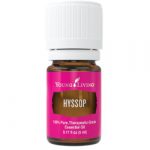TWELVE OILS OF ANCIENT SCRIPTURE: HYSSOP
EDITOR’S NOTE: Since Gary Young’s passing, we have been taking stock of the tremendous contributions he made to the world by revisiting his presentations, such as this fascinating multipart blogpost series called The Twelve Oils of Ancient Scripture. In it, Gary examined the historical significance and traditional uses of frankincense, sandalwood, myrrh, onycha, spikenard, rose of Sharon, myrtle, hyssop, galbanum, cypress, cedarwood, and cassia.
Next up is hyssop, whose intriguing history still has relevance for us today.
 Hyssop may be the most difficult biblical plant to identify because so many possibilities have been suggested. Even though Hyssop officinalis may not be the exact plant used in ancient times, it has similar properties to the aromatic herb mentioned throughout the Bible. A quote from Psalms states, “Purge me with hyssop and I shall be clean; wash me and I shall be whiter than snow (Psalms 51:7).
Hyssop may be the most difficult biblical plant to identify because so many possibilities have been suggested. Even though Hyssop officinalis may not be the exact plant used in ancient times, it has similar properties to the aromatic herb mentioned throughout the Bible. A quote from Psalms states, “Purge me with hyssop and I shall be clean; wash me and I shall be whiter than snow (Psalms 51:7).
The hyssop plant was used just before the exodus from Egypt to dab the Hebrew’s door posts with lamb’s blood, protecting them from the plague of death.
Anciently, leprosy was thought to be the result of the sin of pride. Rabbi Isaac Bartavelle from the third century AD wrote about the use of hyssop in cleansing the leper: “You were proud like the cedar and the Holy One, blessed he, humbled you like this hyssop that is crushed by everyone.”
 The term “officinalis” refers to the fact that hyssop was a part of traditional pharmacopeias. Intriguing historical evidence refers to hyssop being used to treat respiratory conditions and ward off parasites, although current medical research is yet to confirm these uses.
The term “officinalis” refers to the fact that hyssop was a part of traditional pharmacopeias. Intriguing historical evidence refers to hyssop being used to treat respiratory conditions and ward off parasites, although current medical research is yet to confirm these uses.
I hope that you find this information as fascinating as I do! Please join me next time for a discussion of galbanum.
Essentially Yours,
Gary Young
(Originally published January 25, 2010)

